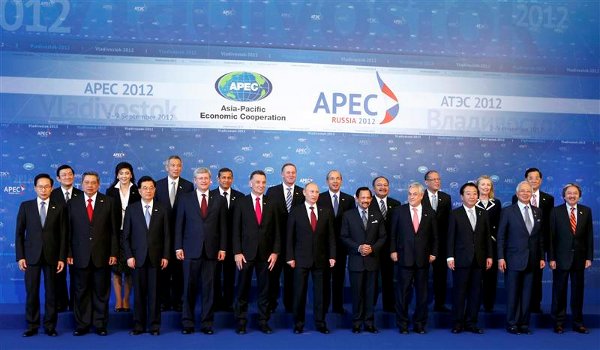|
|
China and Russia Agree on Economic Survival Strategy at APEC Summit
10 September 2012
At the just completed APEC summit in Vladivostok, Russia, one thing was made clear, the path to economic survival in the deepening world depression is paved, tracked, dug, tunnelled, mined, bored, bulldozed, built, or otherwise transformed by man’s mind and hand into productive facilities for the support of mankind’s existence; that is, infrastructure. And much of that infrastructure needs to be built in the Russia Far East and vicinity. The cry for infrastructural development was led by China’s National Development and Reform Commission (NDRC) on Wednesday before the summit, when it announced the approval of 25 new urban rail transit and intercity rail-line projects with a total investment of more than 800 billion yuan ($127 billion) to take place over the next three to eight years. The transit investment will go to improve and expand the already existing transit system in tier-one cities such as Shanghai (158 billion yuan) and Guangzhou (124 billion yuan). Completely new systems will be built for many smaller cities; residents of second-tier cities such as Xiamen in Fujian province, Taiyuan in Shanxi province, and Lanzhou in Gansu province can expect to commute with new subways in the coming years. The NDRC has been accelerating the approval of projects since April, and local governments have launched many stimulus plans to bolster their local economy. The total investment in infrastructure stimulus packages announced by provincial and city governments over the past few months may add up to more than 10 trillion yuan ($1.5 trillion), according to Chinese media reports, but firmly committed funds are not certain at this point. The NDRC also plans to give a "green pass" to low-income housing projects and projects under construction including transportation, telecommunications, railway construction, and strategic emerging industries, to speed the start of such projects. On the next day, the rail transit project announcement was followed an additional NDRC announcement of additional infrastructure spending. Projects, including 1,254 miles of highway in Zhejiang and Xinjiang provinces plus nine sewage treatment plants, two waterway upgrades, and five port and warehouse projects, were added to the mix, making a total of new infrastructure investment of over $150 billion. Chinese President Hu Jintao followed up by delivering a keynote speech to the APEC summit focussing on infrastructure for sustainable growth. Reviewing the current world economy, Hu said it is recovering slowly, and there are still some destabilizing factors and uncertainties. The underlying impact of the international financial crisis is far from over, and some countries are confronted with complex and difficult sovereign debt problems. "Economic growth is facing notable downward pressure, some small and medium enterprises are facing a hard time, and exporters are facing more difficulties." Hu said. "We have an arduous task of creating jobs for new entrants to the labor force."
The Asia-Pacific has, on the whole, maintained sound momentum of growth and acquired a more important position and played a more prominent role in the world economy, the Chinese President said. "However, we should not overlook the impact that the grave challenges in the global economy are having on our region, which we need to address with serious efforts." Addressing the need to upgrade infrastructure in the context of promoting stable growth and recovery, Hu elaborated on China’s views and stances on building infrastructure for sustainable growth. He talked about China’s current economic situation and the recently announced infrastructure projects and economic policies. The region should speed up infrastructure development to strengthen the foundation of development, he said. Infrastructure is essential for achieving economic and social development, he said, adding that governments should play an important role in infrastructure building and step up financial support for infrastructure development. "We should improve and explore new mechanisms for infrastructure investment and financing and encourage participation in infrastructure development by various actors," he said. The Asia-Pacific should strengthen exchanges and cooperation to jointly promote connectivity, roads, railroads, airports, oil and gas pipelines, and electrical transmission lines in the region. |


